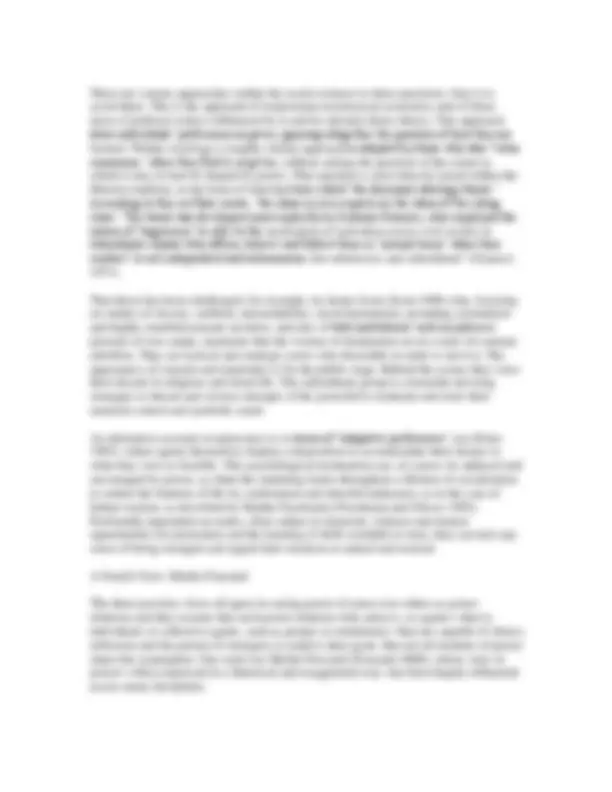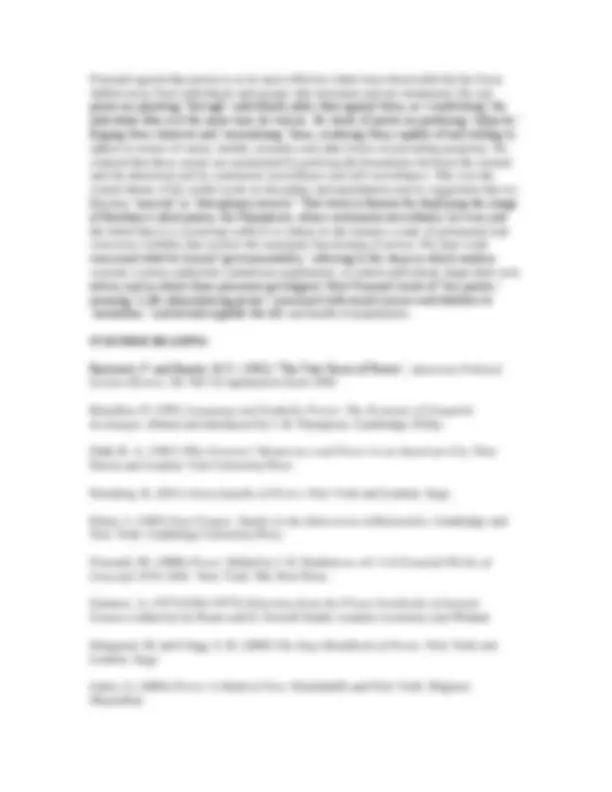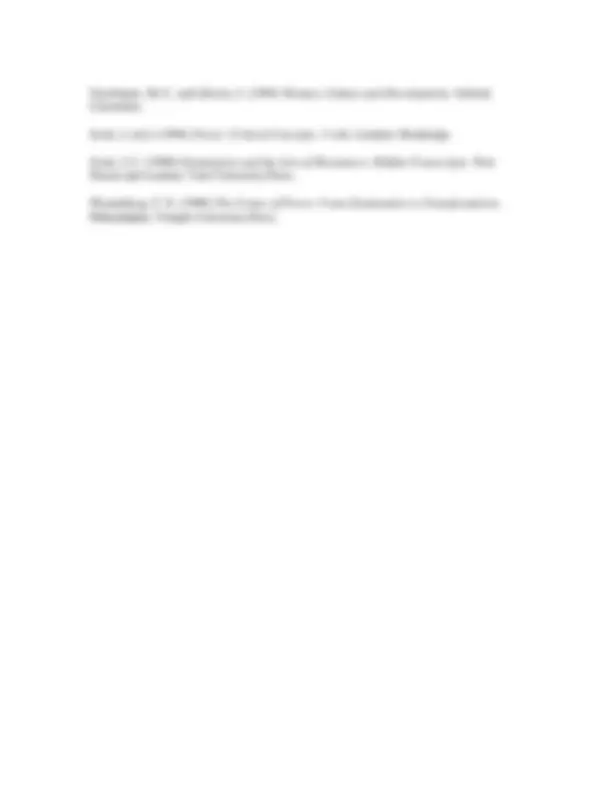





Study with the several resources on Docsity

Earn points by helping other students or get them with a premium plan


Prepare for your exams
Study with the several resources on Docsity

Earn points to download
Earn points by helping other students or get them with a premium plan
Community
Ask the community for help and clear up your study doubts
Discover the best universities in your country according to Docsity users
Free resources
Download our free guides on studying techniques, anxiety management strategies, and thesis advice from Docsity tutors
Various conceptions of power, focusing on its effects on people's lives and how it can be hidden or perceptible. the one-dimensional view of power as conflict between agents, the two-dimensional view that includes agenda control, and Foucault's perspective on power as constituting individuals. The document also mentions the works of scholars like Robert Dahl, Bachrach and Baratz, Pierre Bourdieu, and Michel Foucault.
Typology: Schemes and Mind Maps
1 / 5

This page cannot be seen from the preview
Don't miss anything!




‘Power’ in its most generic sense simply means the capacity to bring about significant effects: to effect changes or prevent them. The effects of social and political power will be those that are of significance to people’s lives. When these effects of power are such as to affect people’s interests adversely we speak of power being held or exercised over them—and the social scientist’s quest is to try to reveal what this involves. There are other ways of identifying social and political power: for instance, as collective power to achieve shared goals (as when people co-operate to promote a cause or pursue a campaign), or as positive or beneficent power, where power serves others’ interests (as, ideally, parents, teachers, philanthropists and social workers are supposed to do (see Wartenberg 1990)). Here we focus on power over others (while noting that power over others will often involve collective power and be combined with beneficent power). Power, thus understood, is arguably the more effective the less perceptible its workings to agents and observers alike (thereby posing a problem for its social scientific study), Four conceptions will be outlined, each claimed by its proponents to reveal more of the phenomenon than its predecessor.
The One-dimensional View
Power is most visibly at work when in a conflict of interests between agents (individual or collective) one prevails over another or others. By exercising power the powerful agent demonstrably has that power but, since power is a capacity, that agent can have the power without exercising it. The conflict, on this view, is between agents’ overt preferences as revealed by their choice behavior and can be interpersonal, within or between organizations, or between countries. It can be legitimate or illegitimate or legitimacy may be what is at issue. And the winning agent may prevail though the rules of the game (as in political decision making or economic markets) or by threats or the offer of rewards.
Thus the political scientist Robert Dahl and his colleagues (Dahl 1961) sought to test the thesis of a ruling power elite by investigating whether in New Haven the preferences of the hypothetical ruling elite regularly prevail. They concluded that there was no power elite, since power, in this first sense, was distributed pluralistically , with different groups prevailing over different key issues.
The Two-dimensional View
Critics (see Bachrach and Baratz 1962) objected that this conclusion resulted from seeing power as only manifested in behavior involving key issues over which there is observable, overt conflict, where that conflict is between the interests of the parties and where their interests consist in their conflicting observable preferences. Power, they claimed, is also at work when the powerful can, with more or less deliberate intent, suppress or thwart challenges to their interests by agenda control: that is, by deciding what gets decided, for example by denying the grievances of marginal or excluded groups a hearing, through a variety of means, from censorship to the manipulation of procedures, thereby preventing potential demands from become actual ones.
This view of power relaxes the requirement that the conflict between parties’ interests be manifested in overt behavior: power must still involve conflict but the conflict can be covert, involving that between dominant interests and the grievances of the excluded or marginalized that have thus failed to be publicly heard. In the face of acquiescence, with no observable conflict between parties, there will, on this view, be no way to determine empirically whether their interests are opposed and thus whether consensus is genuine or has been attained through power.
The Three-dimensional View
This issue has led to a further view, which, it has been claimed, incorporates the previous two but enables one to see further and deeper into the phenomenon (see Lukes 2004). According to this view, power can indeed be at work in ways that are hidden from the view of those subject to it and even of its possessors. The powerful may work to avert conflict by contributing (intentionally or unintentionally) to getting others to want what they want them to want, shaping their perceptions, cognitions and thus preferences. (Of course those subject to such power are typically themselves active participants or subjects, not just its objects or victims). Here power is not just the ability to prevail over others in conflicts of interests and set the agenda of what such conflicts are about: it also encompasses being able to secure their dependence, deference, allegiance or compliance, even without needing to act and in the absence of conflict.
This view rejects three assumptions implicit in the foregoing views. The first is that power must involve positive, intended actions by the powerful. Those subject to their power may anticipate their reactions and so engage, for instance, in self-censorship. They may defer or be attracted to the powerful and regard their subordinate place in the social order as self-evident, natural, unchangeable and even beneficial. Pierre Bourdieu calls such power ‘symbolic power’ and unreflective dispositions so to regard it as ‘habitus’ (Bourdieu 1991). A second assumption is that, since power shows up where there is conflict, conflict is essential to power relations. But sometimes the most effective form of power is the capacity to prevent conflict arising in the first place. The third (most problematic and contested) assumption is that this form of power can deflect people from understanding and thus pursuing their own interests. It can induce them to accept mythical and simplistic beliefs, playing on their fears, prejudices and limited information and their disposition to engage in faulty reasoning. So the power to frame issues and thus help shape beliefs can be the power to mislead, misleading people to support leaders and follow policies that work against their interests.
Difficulties and Alternatives
But how are we to know, in the absence of observable conflict, whether or not apparent acceptance and compliance that we observe has been secured by informational and cognitive power, the power to frame issues and thus help to shape people’s beliefs? More particularly, how would we ascertain whether the consensus results from what we have called the power to mislead: misleading people to support leaders and favor policies that work against their interests?
Foucault agreed that power is at its most effective when least observable but his focus shifted away from individuals and groups who dominate and are dominated. He saw power as operating ‘through’ individuals rather than against them, as ‘constituting’ the individual who is at the same time its vehicle. He wrote of power as producing ‘subjects,’ forging their character and ‘normalizing’ them, rendering them capable of and willing to adhere to norms of sanity, health, sexuality and other forms of prevailing propriety. He claimed that these norms are maintained by policing the boundaries between the normal and the abnormal and by continuous surveillance and self-surveillance. This was the central theme of his earlier work on discipline and punishment and its suggestion that we live in a ‘carceral’ or ‘disciplinary society.’ That work is famous for deploying the image of Bentham’s ideal prison, the Panopticon, where continuous surveillance (or even just the belief that it is occurring) suffices to induce in the inmates a state of permanent and conscious visibility that assures the automatic functioning of power. His later work concerned what he termed ‘governmentality,’ referring to the ways in which modern societies various authorities administer populations, in which individuals shape their own selves, and in which these processes get aligned. Now Foucault wrote of ‘bio-power,’ meaning ‘a life-administering power’ concerned with social science and statistics to ‘normalize,’ control and regulate the life and health of populations.
FURTHER READING
Bachrach, P. and Baratz, M. S. (1962) ‘The Two Faces of Power’, American Political Science Review , 56: 941-52 reprinted in Scott 1994
Bourdieu, P. (1991) Language and Symbolic Power: The Economy of Linguistic Exchanges. Edited and introduced by J. B. Thompson. Cambridge: Polity.
Dahl, R. A. (1961) Who Governs? Democracy and Power in an American City. New Haven and London: Yale University Press
Dowding, K. (2011) Encyclopedia of Power. New York and London: Sage.
Elster, J. (1985) Sour Grapes: Studies in the Subversion of Rationality. Cambridge and New York: Cambridge University Press.
Foucault, M. (2000) Power. Edited by J. D. Faubion as vol. 3 of Essential Works of Foucault 1954-1884. New York: The New Press.
Gramsci, A. (1971[1926-1937]) Selections from the Prison Notebooks of Antonio Gramsci edited by Q. Hoare and G. Nowell-Smith. London: Lawrence and Wishart
Haugaard, M. and Clegg, S. R. (2009) The Sage Handbook of Power. New York and London: Sage.
Lukes, S. (2004) Power: A Radical View. Houndmills and New York: Palgrave Macmillan.
Nussbaum, M. C. and Glover, J. (1995) Women, Culture and Development, Oxford: Clarendon.
Scott, J. (ed.) (1994) Power: Critical Concepts. 3 vols. London: Routledge.
Scott, J. C. (1990) Domination and the Arts of Resistance: Hidden Transcripts. New Haven and London: Yale University Press.
Wartenberg, T. E. (1990) The Forms of Power: From Domination to Transformation. Philadelphia: Temple University Press.